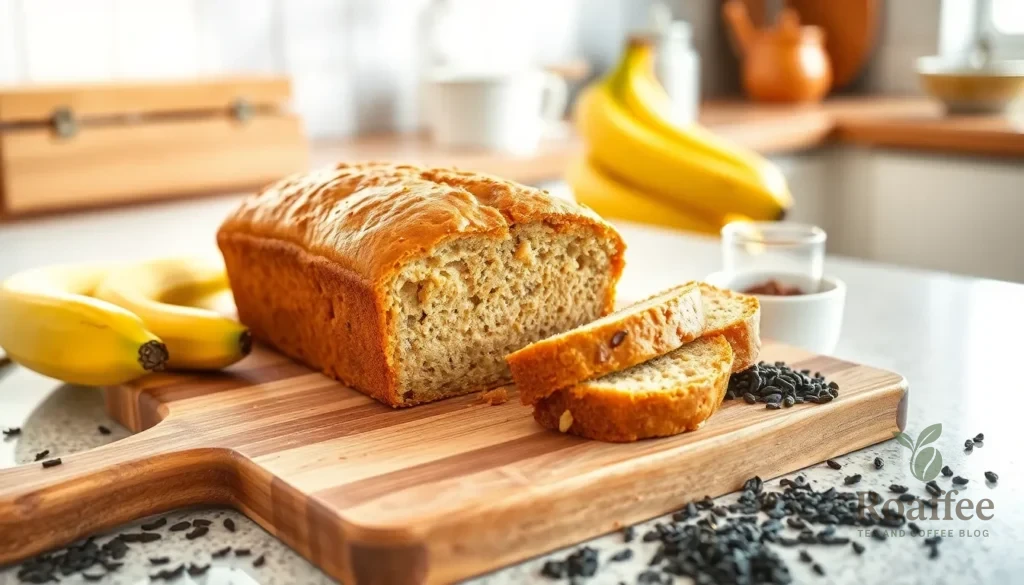There’s nothing quite like the aroma of freshly baked banana bread wafting through your kitchen, and we’re about to share a recipe that’ll make your taste buds sing. Our banana tea bread combines the classic comfort of traditional banana bread with subtle tea-infused notes that create an absolutely irresistible treat.
This isn’t your ordinary banana bread recipe – we’ve elevated it with carefully selected tea flavors that complement the natural sweetness of ripe bananas perfectly. The result? A moist, flavorful loaf that’s perfect for breakfast, afternoon tea, or whenever you’re craving something special.
Whether you’re a seasoned baker or just starting your culinary journey, this recipe delivers consistent results every time. We’ll walk you through each step to ensure your banana tea bread turns out perfectly golden, incredibly moist, and bursting with flavor that’ll have everyone asking for your secret ingredient.
Ingredients
We’ve carefully selected each ingredient to create the perfect balance of banana sweetness and subtle tea essence in this unique bread. Our ingredient list is organized by category to make preparation seamless and efficient.
Dry Ingredients
- 2 cups all-purpose flour
- 1 teaspoon baking soda
- 1/2 teaspoon salt
- 1/2 teaspoon ground cinnamon
- 1/4 teaspoon ground nutmeg
- 2 tablespoons loose black tea leaves (Earl Grey or English Breakfast work best)
Wet Ingredients
- 3 large ripe bananas, mashed (about 1 1/4 cups)
- 1/3 cup melted butter or vegetable oil
- 3/4 cup granulated sugar
- 1 large egg, beaten
- 1 teaspoon vanilla extract
- 1/3 cup brewed tea, cooled (use the same tea variety as the loose leaves)
Optional Add-ins
- 1/2 cup chopped walnuts or pecans
- 1/3 cup mini chocolate chips
- 1/4 cup dried cranberries or raisins
- 1 tablespoon lemon zest for citrus brightness
Equipment Needed
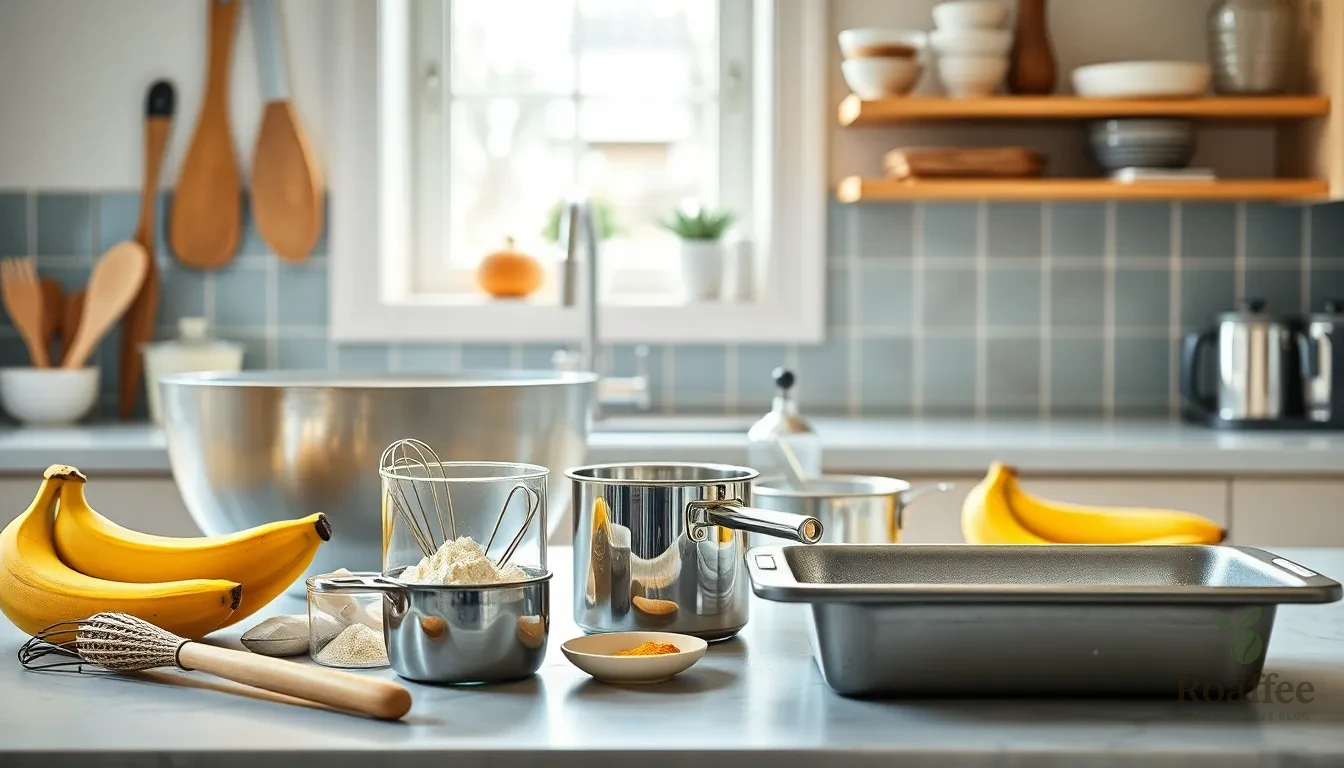
Gathering the proper equipment before we begin ensures smooth preparation and optimal results for our banana tea bread. We recommend having these essential tools ready to streamline the baking process.
Our mixing station requires a large mixing bowl for combining ingredients and a whisk for thorough blending. A heatproof bowl becomes necessary when we prepare the tea syrup since we’ll be working with hot liquids. We’ll also need measuring cups and spoons to ensure accurate ingredient proportions.
For the tea preparation process, we need a small saucepan to boil water and create our signature tea syrup. This specialized step sets our banana tea bread apart from traditional recipes.
The baking phase requires a loaf pan that we’ll grease beforehand to prevent sticking. Our oven must be preheated to 350°F to achieve the perfect texture and golden color. A spatula helps us fold ingredients gently without overmixing the batter.
Additional helpful tools include a wire cooling rack for proper cooling and a toothpick for testing doneness. Having these items prepared and within reach allows us to focus on technique rather than searching for equipment mid-recipe.
| Equipment Category | Essential Items |
|---|---|
| Mixing Tools | Large mixing bowl, whisk, heatproof bowl |
| Measuring Tools | Measuring cups, measuring spoons |
| Cooking Equipment | Small saucepan, spatula |
| Baking Equipment | Loaf pan, oven (350°F), wire cooling rack |
Setting up our workspace with these tools creates an efficient environment for crafting this unique tea-infused banana bread.
Instructions
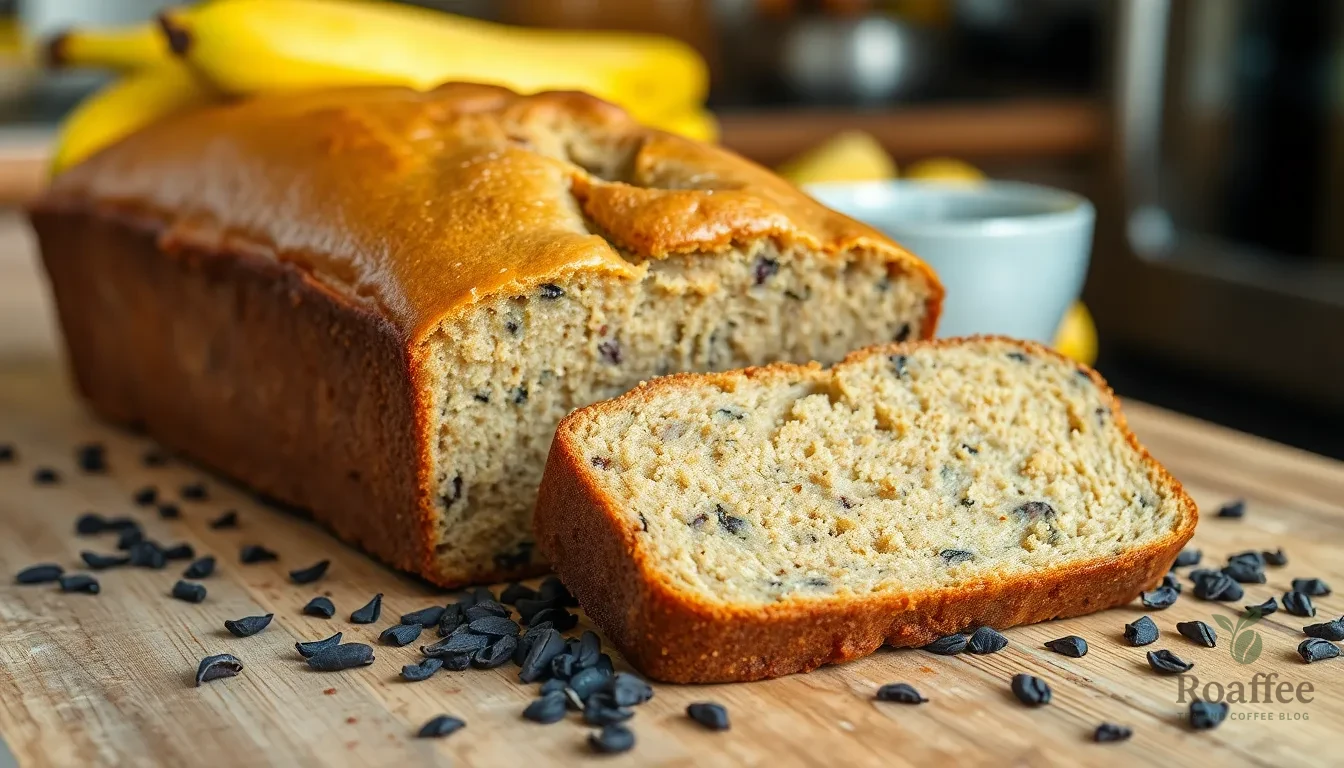
Now we’ll walk through the complete process of creating this delicious banana tea bread. Each step builds upon the previous one to ensure our loaf turns out perfectly moist and flavorful.
Prep
We begin by preheating our oven to 350°F (180°C) and lightly greasing an 8.5 x 4.5 inch or 9 x 5 inch loaf pan. In a large mixing bowl, we sift together 1¾ cups of all-purpose flour, 2 teaspoons of baking powder, ¼ teaspoon of baking soda, and ½ teaspoon of salt. This sifting process ensures our dry ingredients are evenly distributed and creates a lighter texture in our finished bread. We can also incorporate our loose black tea leaves, ground cinnamon, and ground nutmeg at this stage for optimal flavor distribution.
Making the Batter
We start by creaming ⅓ cup of softened butter with ⅔ cup of granulated sugar until the mixture becomes light and fluffy. Next, we beat in 2 eggs thoroughly, ensuring each egg is fully incorporated before adding the next. The key to success lies in alternating our dry ingredients with 1 cup of mashed ripe bananas, mixing gently after each addition until the batter just comes together. We fold in our brewed tea at this point, followed by the vanilla extract and any optional add-ins like chopped nuts or chocolate chips. Overmixing can result in a dense loaf, so we stir only until the ingredients are just combined.
Baking
We pour our prepared batter into the greased loaf pan, spreading it evenly with a spatula. The bread bakes at 350°F for approximately 1 hour to 1 hour and 10 minutes, depending on our pan size and oven characteristics. We test for doneness by inserting a toothpick into the center of the loaf. When it comes out clean or with just a few moist crumbs, our banana tea bread is ready. The top should be golden brown and spring back lightly when touched.
Cooling
We remove our finished bread from the oven and allow it to cool in the pan for 10 minutes. This resting period prevents the bread from breaking apart when we turn it out. After 10 minutes, we carefully turn the loaf onto a wire cooling rack to cool completely. Once cooled, we wrap the bread in greaseproof paper and foil for storage. Properly stored at room temperature, our banana tea bread stays fresh for up to 3 days or can be frozen for up to 4 weeks.
Directions for Serving
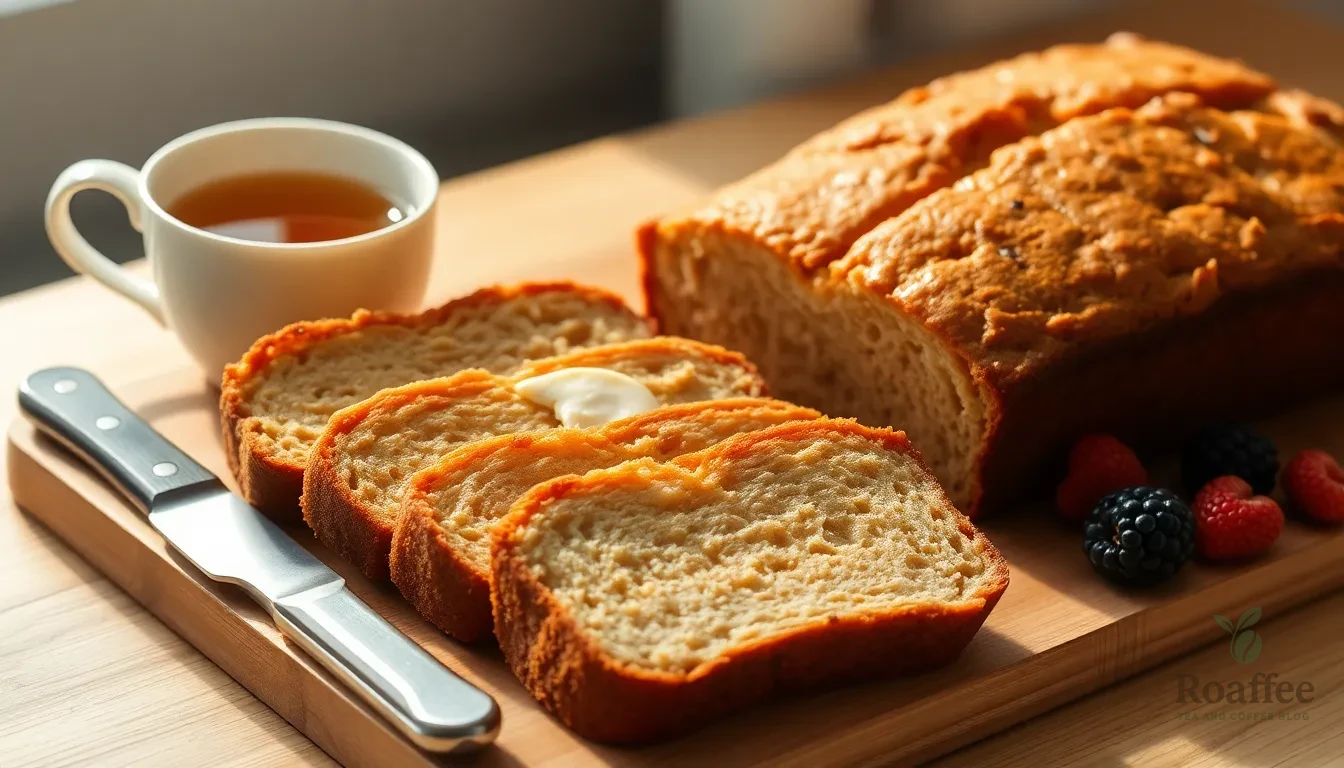
We recommend allowing the banana tea bread to cool completely before slicing to achieve the best texture and prevent crumbling. The bread should rest for at least 15 minutes on a wire cooling rack after removing it from the pan.
Slicing Technique
Use a sharp serrated knife to cut clean slices approximately 3/4 inch thick. We find that wiping the blade between cuts helps maintain neat edges and prevents the moist crumb from sticking to the knife.
Temperature Preferences
Serve the banana tea bread at room temperature for the fullest flavor profile. The tea notes become more pronounced when the bread is not chilled. For those who prefer warm bread we suggest lightly toasting individual slices in a toaster or under the broiler for 1-2 minutes.
Accompaniment Options
Spread butter or cream cheese on each slice for added richness that complements the banana and tea flavors. We particularly enjoy pairing this bread with honey butter or a light dusting of powdered sugar for special occasions.
Beverage Pairings
This tea bread pairs exceptionally well with hot beverages. We recommend serving it alongside English breakfast tea coffee or chai to enhance the subtle tea notes already present in the bread. Fresh fruit such as berries or sliced apples make excellent side accompaniments.
Portion Guidelines
| Serving Size | Typical Portions | Occasion |
|---|---|---|
| 1 slice | Light snack | Mid-morning break |
| 2 slices | Breakfast portion | Weekend brunch |
| 3 slices | Dessert serving | Afternoon tea |
Storage Between Servings
Keep remaining slices covered with plastic wrap or store in an airtight container at room temperature. We find that wrapping individual slices makes for convenient grab-and-go portions throughout the week.
Make-Ahead Instructions
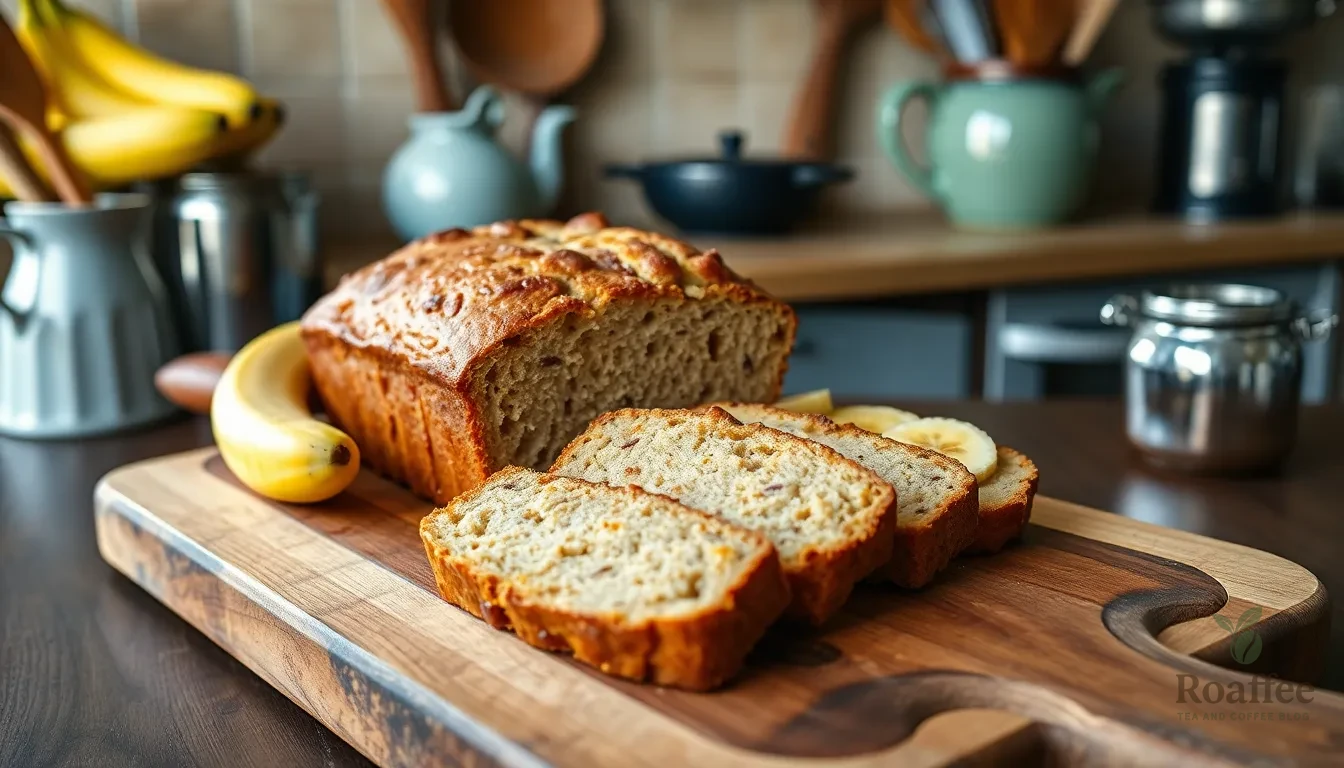
We can prepare this banana tea bread in advance to save time and ensure we always have a delicious treat ready to enjoy. The nature of this recipe makes it perfect for meal prep and advance planning.
Prepare the Batter in Advance
We recommend mixing the dry ingredients up to 24 hours ahead and storing them in an airtight container at room temperature. The wet ingredients can be combined and refrigerated for up to 12 hours before baking. This approach allows us to simply combine the mixtures and bake when ready.
Fully Baked Make-Ahead Options
Once our banana tea bread is completely cooled, we can wrap it tightly in plastic wrap or aluminum foil. The bread stays fresh at room temperature for up to 3 days, maintaining its moist texture and tea-infused flavor. For longer storage, we can freeze the wrapped loaf for up to 4 weeks without compromising quality.
Freezing Individual Portions
We find it convenient to slice the cooled bread and wrap individual pieces in plastic wrap before placing them in a freezer-safe bag. This method allows us to thaw only the portions we need. Individual slices defrost in about 30 minutes at room temperature or can be warmed in the microwave for 15-20 seconds.
Refresh Day-Old Bread
When our banana tea bread is a day or two old, we can restore its fresh-baked texture by wrapping it in a damp paper towel and microwaving for 10-15 seconds. Alternatively, we can warm slices in a 300°F oven for 5-7 minutes to revive the aromatic tea notes and soft crumb.
Storage Tips
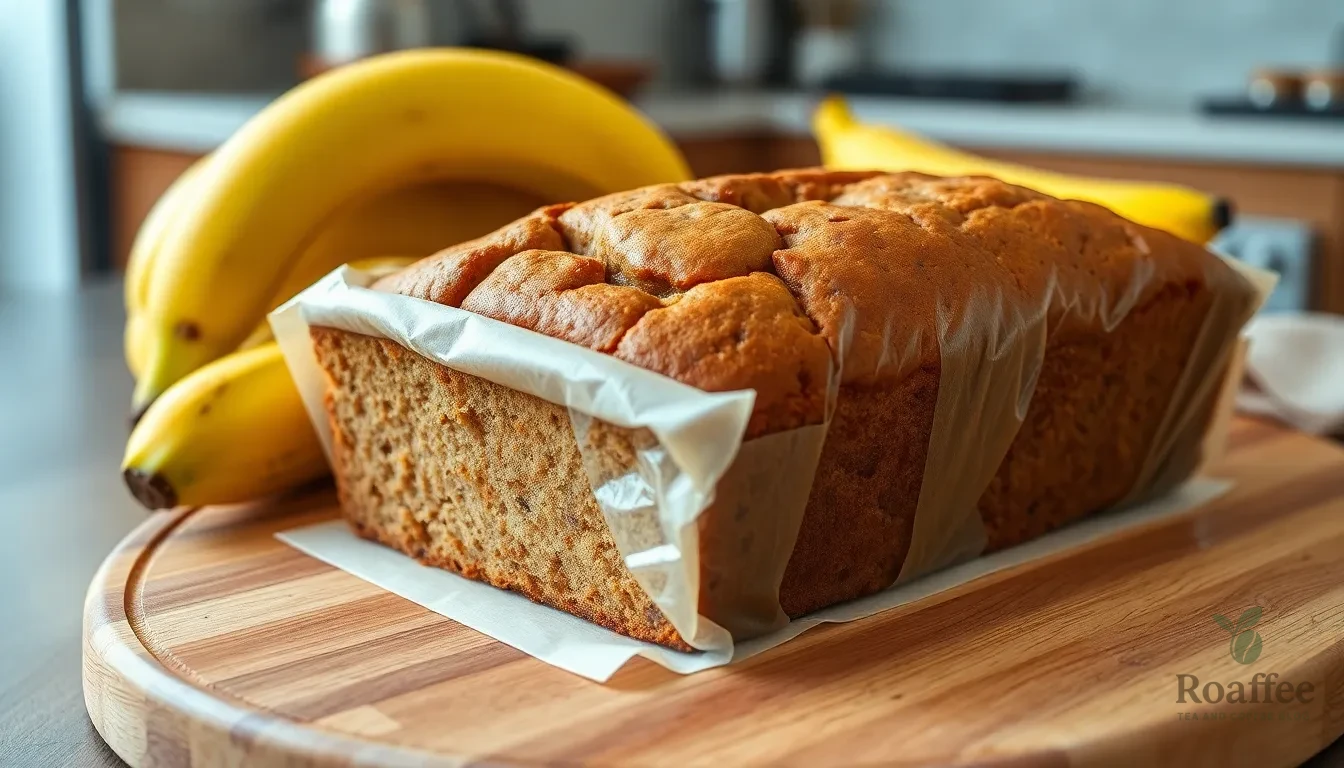
We recommend allowing your banana tea bread to cool completely before storing to prevent trapped moisture that can make the loaf soggy. Room temperature storage works best for maintaining the bread’s texture and flavor.
Room Temperature Storage
Store your cooled banana tea bread in an airtight container at room temperature for up to 1 week. We suggest wrapping the loaf first in parchment paper then plastic wrap before placing it in your container for extra moisture protection. This double-wrapping method helps preserve the bread’s soft crumb while preventing it from drying out.
| Storage Method | Duration | Best For |
|---|---|---|
| Room Temperature (airtight container) | Up to 1 week | Daily consumption |
| Freezer (wrapped tightly) | Up to 3 months | Long-term storage |
| Individual slices (frozen) | Up to 4 weeks | Convenient portions |
Freezer Storage for Extended Freshness
For longer storage up to 3 months, we wrap the completely cooled loaf tightly in plastic wrap followed by aluminum foil to prevent freezer burn. This double protection maintains the bread’s moisture and prevents ice crystals from forming. Thaw frozen banana tea bread in the refrigerator overnight before serving.
Individual Slice Storage
We find freezing individual slices particularly convenient for quick snacks. Wrap each slice in plastic wrap and store in a freezer-safe bag. These portions thaw quickly at room temperature in about 30 minutes.
Moisture Control Tips
Place paper towels beneath and on top of your banana tea bread inside the airtight container to absorb excess moisture. This technique helps maintain the perfect texture for several days. We avoid refrigerating banana tea bread as the circulating cool air dries out the loaf quickly.
Refreshing Stored Bread
Toast leftover banana tea bread lightly to restore its fresh-baked texture. We enjoy serving it with butter, honey, cream cheese, or Nutella for an enhanced flavor experience.
Variations and Substitutions
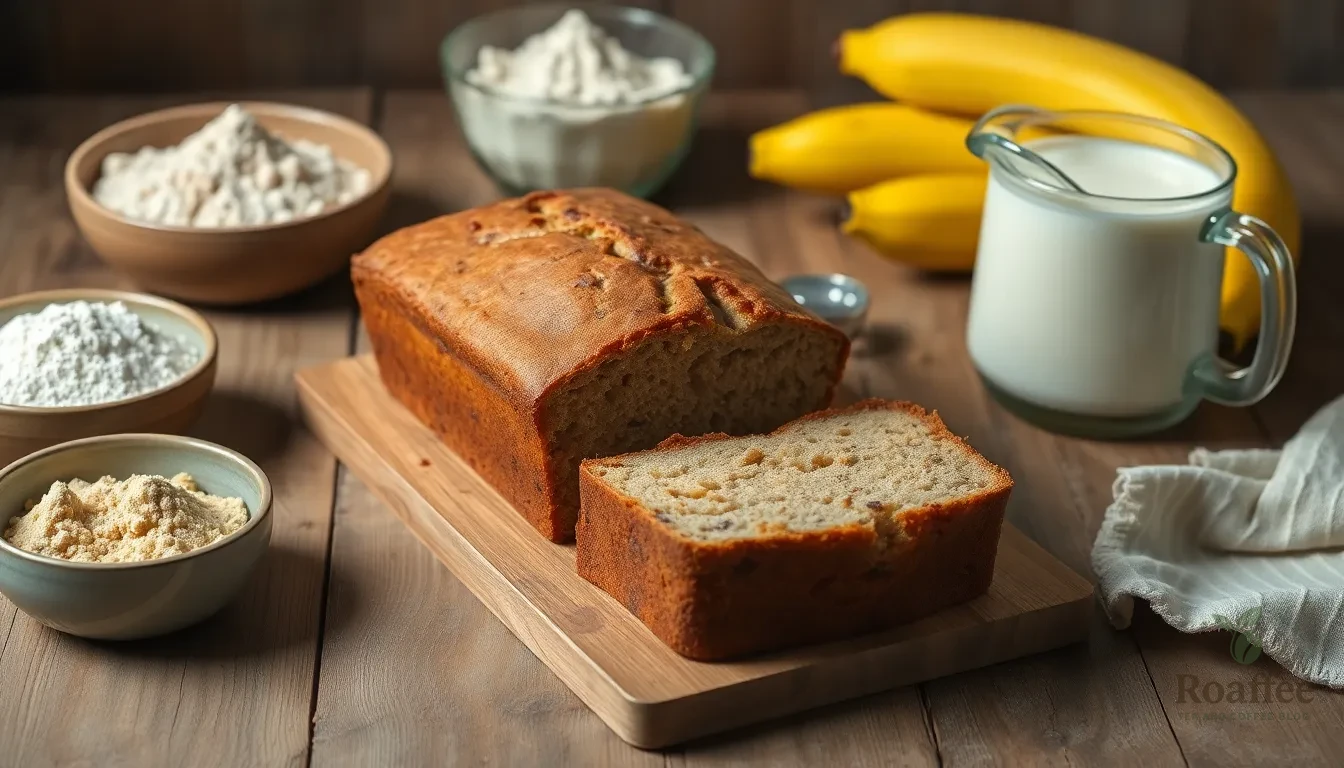
Our banana tea bread recipe adapts beautifully to accommodate different dietary needs and flavor preferences. These modifications ensure everyone can enjoy this delightful teatime treat regardless of their dietary restrictions.
Gluten-Free Option
We recommend creating a custom flour blend using buckwheat flour, gluten-free oat flour, almond flour, and tapioca starch for optimal texture and taste. This combination produces a moist, soft crumb that rivals traditional wheat flour versions. Flax meal serves as an excellent binding agent, replacing some of the gluten’s structural properties while adding nutritional benefits.
| Flour Type | Amount | Purpose |
|---|---|---|
| Buckwheat flour | 3/4 cup | Base structure |
| Gluten-free oat flour | 1/2 cup | Moisture retention |
| Almond flour | 1/4 cup | Richness and texture |
| Tapioca starch | 2 tablespoons | Binding and elasticity |
Substitute the regular milk with non-dairy alternatives like almond, soy, or oat milk. Extra light olive oil works wonderfully in place of butter, maintaining the bread’s tender crumb. Add an extra tablespoon of flax meal mixed with water to enhance the binding properties and create the perfect gluten-free banana tea bread.
Vegan Alternative
Plant-based substitutions transform our banana tea bread into a completely vegan-friendly recipe without sacrificing flavor or texture. Replace eggs with flax eggs by mixing 2 tablespoons of ground flax meal with 6 tablespoons of water, allowing the mixture to sit for 5 minutes until it becomes gel-like.
Swap dairy milk for your preferred plant-based milk such as almond, soy, or oat milk. Vegan butter or coconut oil replaces regular butter effectively. Natural sweeteners like maple syrup or coconut sugar can substitute granulated sugar while adding complex flavors that complement the tea notes.
These plant-based ingredients maintain the bread’s characteristic moistness and create a rich, satisfying texture. The flax eggs provide binding strength while contributing omega-3 fatty acids to boost the nutritional profile.
Flavor Variations
Our base recipe welcomes many flavor enhancements that transform the bread into exciting new variations. Chopped walnuts or pecans add delightful texture and nutty richness that pairs beautifully with the tea flavors. Mini chocolate chips create an indulgent twist, while semi-sweet or dark chocolate varieties offer different intensity levels.
Spice additions elevate the complexity of our banana tea bread significantly. Ground cinnamon and nutmeg enhance the warm, comforting notes, while vanilla extract amplifies the overall flavor profile. Fresh blueberries introduce bursts of tartness that balance the sweetness perfectly.
Create a cinnamon sugar crust by mixing 2 tablespoons of granulated sugar with 1 teaspoon of ground cinnamon, then sprinkling this mixture over the batter before baking. This addition provides a delightful textural contrast and an extra layer of sweetness that makes each slice irresistible.
Dried cranberries or raisins offer chewy texture and concentrated fruit flavors, while lemon zest brightens the entire loaf with citrusy notes that complement the tea infusion beautifully.
Troubleshooting Tips
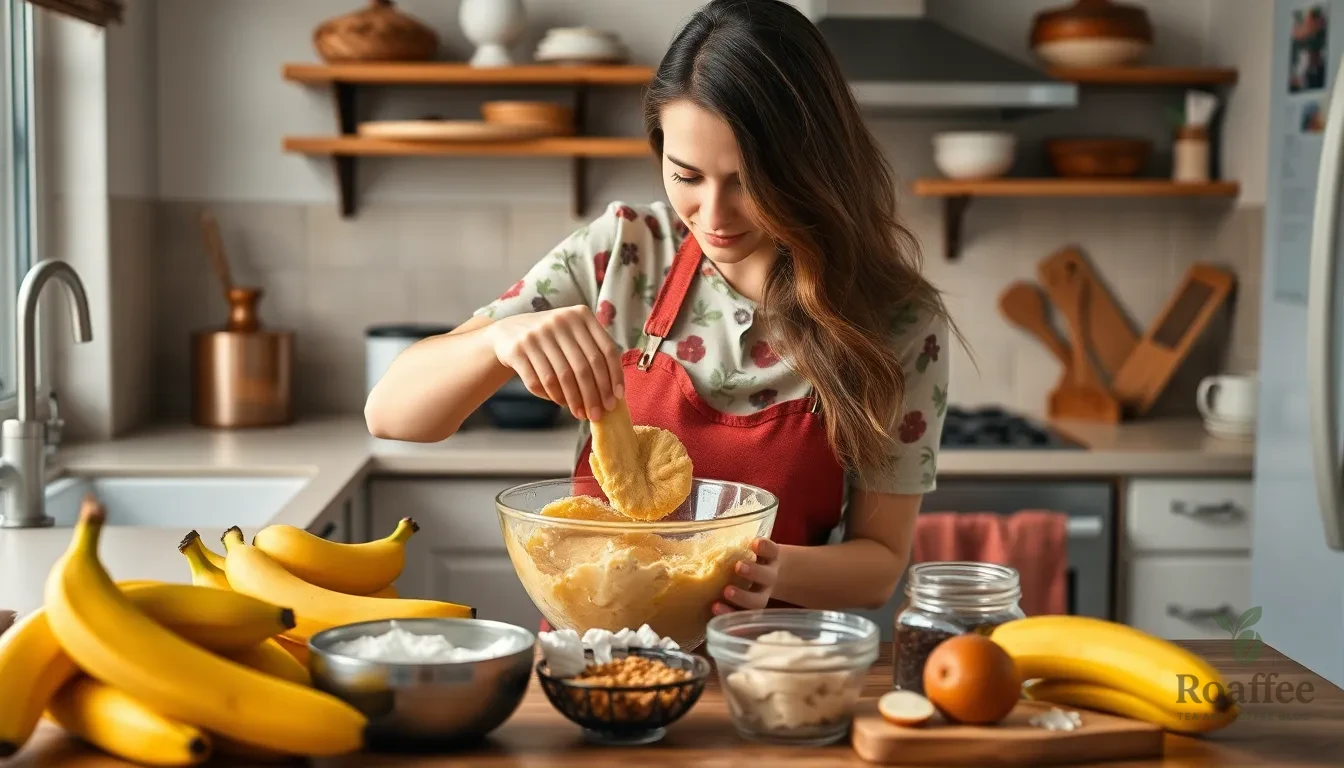
Even experienced bakers encounter challenges when making banana tea bread. We’ve compiled the most common issues and their answers to help you achieve perfect results every time.
Overmixing Creates Dense Texture
We cannot stress enough how important gentle mixing becomes when combining wet and dry ingredients. Overmixing develops gluten strands that create a dense and rubbery texture instead of the light crumb we want. Mix dry ingredients by hand using a spatula and fold them into the wet mixture until just combined. Stop mixing as soon as you no longer see dry flour streaks.
Banana Ripeness Affects Flavor and Moisture
The ripeness of your bananas directly impacts both taste and texture. We recommend using very ripe bananas with brown spots covering the peel for maximum sweetness and natural moisture. Underripe bananas produce less flavorful bread with poor texture. Your bananas should mash easily and smell fragrant when ready to use.
Excess Bananas Create Gummy Results
Too many bananas add excessive moisture that prevents proper rising and creates a gummy interior. We stick to the recipe’s specified amount of 2-3 ripe bananas for optimal results. Adding more bananas might seem like it would enhance flavor but actually creates structural problems that affect the final texture.
Flour Measurement Errors Lead to Dry Bread
Incorrect flour measurement ranks among the top causes of banana tea bread failure. We use the spoon-and-level method rather than scooping flour directly with the measuring cup. Scooping packs too much flour into the cup and creates dry heavy bread. Spoon flour into your measuring cup and level it with a knife for accurate measurement.
Oven Temperature Consistency Prevents Collapse
Opening the oven door during baking causes temperature fluctuations that can make your bread collapse. We keep the oven door closed for the first 45 minutes of baking to maintain consistent heat. Check doneness only after the minimum baking time by inserting a skewer into the center. The skewer should come out clean or with just a few moist crumbs.
Electric Mixers Compromise Texture
Hand mixing preserves the delicate texture better than electric mixers or food processors when incorporating dry ingredients. We save electric mixers for creaming butter and sugar but switch to manual mixing for the final steps. This gentle approach maintains the light fluffy texture that makes banana tea bread special.
| Common Problem | Primary Cause | Solution |
|---|---|---|
| Dense texture | Overmixing | Hand fold ingredients until just combined |
| Bland flavor | Underripe bananas | Use very ripe bananas with brown spots |
| Gummy interior | Too many bananas | Stick to 2-3 bananas maximum |
| Dry bread | Excess flour | Use spoon-and-level measuring method |
| Collapsed bread | Temperature fluctuations | Keep oven door closed during baking |
Conclusion
We’ve crafted this banana tea bread recipe to bring something truly special to your kitchen. The combination of ripe bananas and aromatic tea creates a unique flavor profile that’ll become your new favorite comfort food.
Whether you’re serving it for breakfast with butter or enjoying a slice during afternoon tea this recipe delivers consistent results every time. The troubleshooting tips we’ve shared will help you avoid common pitfalls and achieve that perfect moist texture.
Don’t hesitate to experiment with the variations we’ve suggested. From gluten-free adaptations to creative add-ins like chocolate chips or nuts there’s endless potential to make this recipe your own. Your family and friends will be impressed by this delightful twist on traditional banana bread.
Frequently Asked Questions
What makes banana tea bread different from regular banana bread?
Banana tea bread combines traditional banana bread flavors with subtle tea-infused notes. The recipe incorporates both loose black tea leaves and brewed tea as ingredients, creating a unique flavor profile that’s perfect for breakfast or afternoon tea while maintaining the moist, comforting texture of classic banana bread.
What ingredients do I need to make banana tea bread?
You’ll need dry ingredients (all-purpose flour, baking soda, salt, cinnamon, nutmeg, loose black tea leaves) and wet ingredients (ripe bananas, melted butter or oil, sugar, egg, vanilla extract, brewed tea). Optional add-ins include nuts, chocolate chips, dried fruit, or lemon zest for extra flavor.
How ripe should the bananas be for this recipe?
Use very ripe bananas with brown spots on the peel for the best flavor and texture. Overripe bananas are sweeter, mash easily, and provide more moisture to the bread. Avoid green or just-yellow bananas as they won’t contribute enough sweetness or banana flavor to the recipe.
Can I make this recipe gluten-free or vegan?
Yes, you can adapt this recipe for dietary needs. For gluten-free, substitute all-purpose flour with a 1:1 gluten-free flour blend. For vegan options, replace the egg with a flax egg and use plant-based milk for brewing the tea. These substitutions maintain the bread’s delicious tea-infused essence.
How should I store banana tea bread?
Store the completely cooled bread wrapped tightly in plastic wrap or aluminum foil at room temperature for up to 3 days. For longer storage, wrap and freeze for up to 4 weeks. Always allow the bread to cool completely before slicing to prevent crumbling and maintain optimal texture.
What’s the most common mistake when making banana tea bread?
Overmixing the batter is the most common mistake, which leads to dense, tough bread. Mix ingredients just until combined using a spatula or wooden spoon rather than an electric mixer. The batter should look slightly lumpy, and a few streaks of flour are perfectly acceptable.
What equipment do I need to bake banana tea bread?
Essential equipment includes a large mixing bowl, whisk, measuring cups and spoons, a 9×5-inch loaf pan, and a spatula for mixing. You’ll also need a wire cooling rack and basic kitchen tools. No special equipment is required, making this recipe accessible for both beginners and experienced bakers.

